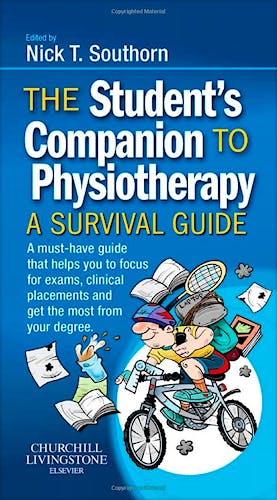

No hay productos en el carrito



The Student's Companion to Physiotherapy. A Survival Guide
Southorn, N.
1ª Edición Enero 2010
Inglés
Tapa blanda
170 pags
500 gr
18 x 23 x null cm
ISBN 9780702033803
Editorial CHURCHILL LIVINGSTONE
Description:
The Student's Companion to Physiotherapy is a comprehensive guide to help ease the stresses and strains of studying physiotherapy. It puts a lighter spin on a very challenging time but is very informative, identifying the vital facts in anatomy and physiology; neurological physiotherapy; electrotherapy; respiratory physiotherapy; musculoskeletal physiotherapy; pharmacology; bio-psychosocial approach; paediatrics; portfolio development; and methods of work/assessment. The content here is orchestrated by students wanting to share their knowledge with fellow students and this book will be a trusty companion for all budding physiotherapists.
Features:
- Offers students unique learning and study skills needed for physiotherapy
- Specifies useful ways to study and offers advice on portfolio development and communication as a clinician
- Anecdotes, "top tips" boxes and cartoons
- Handy hints on portfolio development, research and job applications
Table Of Contents:
Contributors
Acknowledgements
Editor ’s introduction
An introduction by Professor the Baroness Finlay of Llandaff, MD, FRCP
SECTION 1 SETTLING IN
Chapter 1 In the beginning
Nick Southorn and Jamie Mackler
Day one
What is physiotherapy?
A brief history of physiotherapy
Physiotherapists at work
International organizations
Swatting up
Books to buy
Equipment
Freshers ’ week
Study tips
Being a member of the representative body of physiotherapy
Chapter 2 Things I wish they’d told me before I started
Stuart Porter
What am I letting myself in for?
Not sure I deserve to be here
What is different about studying at degree level?
The language of the university
How to conduct yourself
What your lecturers expect from you
How do I get through the first year?
What you should expect from your lecturers
How to get through your exams
Finally
SECTION 2 STUDYING PHYSIOTHERAPY
Chapter 3 Anatomy and physiology
Nick Southorn
Introduction - anatomy
Visualizing anatomy
Mnemonics and chants
Introduction - physiology
Learning physiology
'Tool box'
In the clinic
Conclusion
Chapter 4 Musculoskeletal physiotherapy
Nick Southorn
So what is musculoskeletal therapy?
Initial subjective assessment
Initial objective assessment
Clinical semaphore
Treatments
Maitland
Cyriax/orthopedic medicine
McKenzie
Acupuncture
Muscle energy techniques
Myofascial therapy
Pilates
Exercise therapy
Massage
In the clinic
Chapter 5 Electrotherapy
Tim Watson
What is it?
Why is it important?
Useful ways to study
Resources and information
Chapter 6 Cardiopulmonary physiotherapy
Mandy Jones
Learning the theory
Tips for learning anatomy
Tips for learning physiology
Tips for learning physiotherapy
Preparation for clinical placement
Tips for clinical placement
Hazards of clinical placement
Conclusion
Chapter 7 Neurologic physiotherapy
Nick Southorn
What you need to know
Basics
Conditions
Assessment
Treatment of the neurologic patient
In the clinic
Chapter 8 Pharmacology
Nick Southorn
How do I get my head around all of this?
It’s all about class!
What do I need to know about these drugs?
In the clinic
Conclusion
Chapter 9 Biopsychosocial approach
Paul Watson
Why a biopsychosocial perspective?
A biopsychosocial model of pain disability
So what are the important things to consider?
In the clinic
Integrating assessment into practice
Conclusion
Chapter 10 Pediatrics
Nick Southorn
Be a child, it helps!
Childhood diseases
How to assess a child patient
Subjective assessment
Objective assessment
Treatments
Conclusion
Chapter 11 Clinical placement
Nick Southorn
How to prepare
What you need to know before you get there
Uniform etiquette
What you need to know when you get there
The learning agreement
Marking criteria
The role of the clinical educator
The role of the academic tutor
Conclusion
SECTION 3 THE FINAL STRETCH
Chapter 12 Clinical audit and research
Herbert Thurston
Clinical audit
Research
Types of research
Getting started in research
Real-life researchers
Chapter 13 The degree continues
Nick Southorn and Nick Clode
Professional practice
Evidence-based practice
Portfolio development
What is a CPD portfolio?
Why do I need to keep a CPD portfolio?
What does a portfolio look like?
What should it contain?
Portfolio keeping - what you need to know
Online versus paper-based portfolio systems
Steps in setting up a CPD portfolio
Finally
Reflection
Chapter 14 You think it’s all over …
Nick Southorn and Nick Clode
Results
What to do with your textbooks
Opportunities for the graduate
Looking for jobs in the UK
Websites
Recruitment agencies
Interviews
Interview format
Preparation
Interview tips
Appearance
On the day
Conclusion
Edited by Nick Southorn, BSc (Hons), MCSP, SRP, Chartered Physiotherapist, Derbyshire, UK
© 2025 Axón Librería S.L.
2.149.0